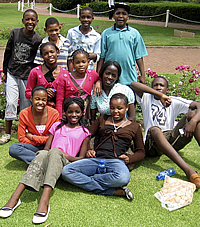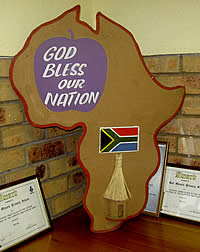
by Mark Belinsky and Emily Jacobi
Pretoria, South Africa— "Long time ago, South Africa wasn’t having peace," explained Thabiso, 13. "Many people were fighting, black and white were fighting for peace. And they couldn’t get peace. Now, we are free to have peace, us youngsters. Because our grandmothers, our mothers were fighting for us to be free."
For South Africans born after 1994, their country is a very different place than the one where their parents grew up. That year marked the end of the Apartheid system, a set of rules and policies that for decades segregated South Africans based on the color of their skin. Under Apartheid, people were unable to move freely around the country. Black South Africans were the most poorly treated. Although they represented a majority of the population, they were stripped of their citizenship, including the right to vote.
“Apartheid was the discrimination against black by the white people,” said Lindo, 14. “There were toilets for black and for whites. There were shops that black people were not allowed to enter. Black people were supposed to carry a passbook everywhere they went. If they caught you without a passbook, they would arrest you.”
On April 27,1994, everything changed. For the first time, South Africans of all races voted in democratic elections, electing former political prisoner President Nelson Mandela of the African National Congress. The laws enforcing segregation were dismantled, and in 1996 a new constitution was signed, guaranteeing broad political, social and cultural rights. These included the rights to speech and assembly, housing, health care and education.
In the new South Africa, everything is different, but that doesn’t mean there aren’t problems. Even as the political system changed for the better, a deadly disease—HIV/AIDS—spread rapidly through the country, orphaning large numbers of youth. Currently, 20 percent of the adult population is estimated to have HIV/AIDS, and more than 30 percent of South Africa’s population is fourteen years old and younger.
Youth face other problems, too. Although there is no longer forced segregation of schools, some young people have to travel far, or leave their families, in order to find a quality education. Young people who come as migrant workers and refugees from neighboring countries including Mozambique, Zimbabwe and the Congo face discrimination and attacks. And many youth are orphaned or homeless—childcare workers estimate as many as 12,000 youth live on the streets in South Africa.
In October 2008 we traveled to South Africa. On our trip, we wondered, what is it like for South African youth growing up today, fourteen years after the end of Apartheid? How much do they think about history versus present realities? What are their thoughts on the challenges the country is facing? What are their hopes and dreams for the future?
We partnered with Khulisa to work with a group of thirteen young people who live in two shelters in Pretoria, South Africa’s administrative capital. Over the course of five days they learned how to take pictures with digital cameras and edit the images on computers. We interviewed them about their lives, and traveled with them—on a photo shoot around the city, and with the boys to school, a twenty-minute train ride away from their shelter. Below are the audio slideshows that share their voices and stories.
 |
Hopes and Dreams Who are the youth of Tshwane Home of Hope and Child Soul Care? What makes them happy? What are their goals for the future? Here, seven of the young people share their stories. |
 |
Culture in the New South Africa “We have culture to remember our grandparents, remember how they used to celebrate their culture,” said Nancy, 13. Nancy, Nosphiwe and Zozuku used their cameras to document culture in South Africa. Here, Zozuko, 12, explains what culture means to her. |
 |
The Journey to School For the boys at Child Soul Care, the day starts early, at 4 am. The shelter houses 33 young people who must clean themselves and their dorms before eating breakfast and heading to school. Lindo, Happy, Alfred and Lucky must leave early—around 6:30 am—to get to school on time. They walk a kilometer to the train station, then take a train to one Pretoria’s outlying areas, called a township, to start their school day. |
 |
The kids, ages 10-14, were all born after the end of Apartheid, yet they were all aware of its legacy. “My hero is Thabo Mbeki (president from 2002-2008) and Nelson Mandela, who was fighting for us for freedom,” said Happy, 14. “Mandela, he lived in jail for 27 years for freedom, so that we could live in peace.” Watch Happy and Lindo discuss life after Apartheid. |
About the shelters: The young people behind this project live apart from their families for various reasons—some had been separated from their families and were living on the streets of Pretoria. Some have lost both parents. Others still get to visit their families from time to time, but were placed in the shelters so they could get a better education. The girls stay at Tshwane Home of Hope, and the boys at Child Soul Care.
The adults at the two shelters were extremely welcoming, and opened up space for the training. Although many of the young people had been through hardships, in our interviews they preferred to focus on the positives—what they are hopeful about, their friends at the shelter, and what makes them happy.
“Here (at Child Soul Care) they help people,” said Alfred, 14. “Some come because they aren’t getting a proper education, some are neglected from their rights. Some come because don’t have parents. They come here to get their education. And be someone they choose.”
About Mark and Emily: For the past two years we have collaborated on media projects through our production company, New Words. In 2007 we interviewed the next generation of young Burmese activists in Thailand and published a report with the Center for Peace Building International. In 2008, with support from What Kids Can Do, we created photo essays and a book with Burmese refugee youth on the Bangladesh border. The young photographers named our collaboration Project Einstein, “because Einstein was a refugee but could still do great things.” Watch their photo essays here. We recently founded a nonprofit called Digital Democracy, aimed at empowering civic engagement through new technologies.

